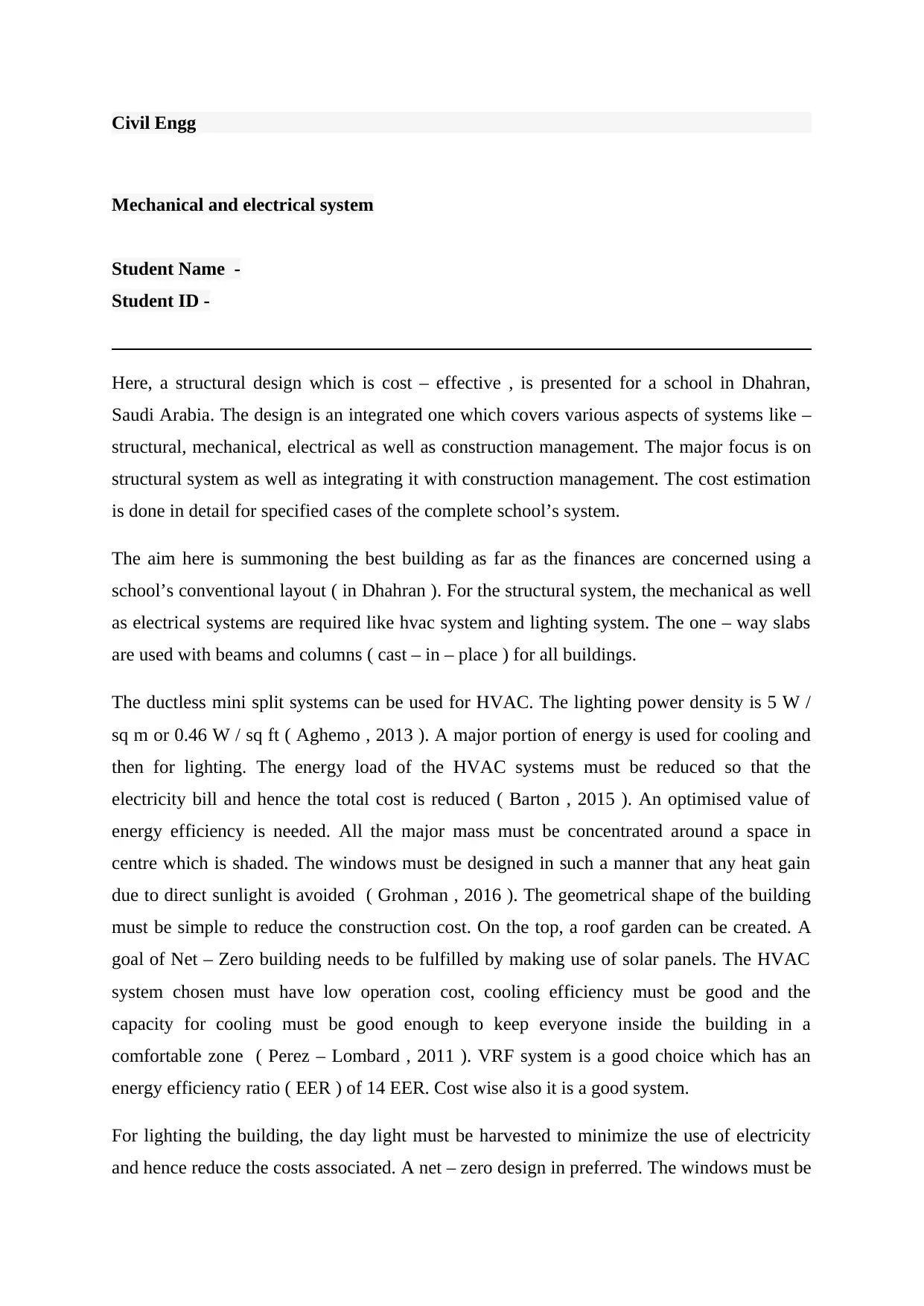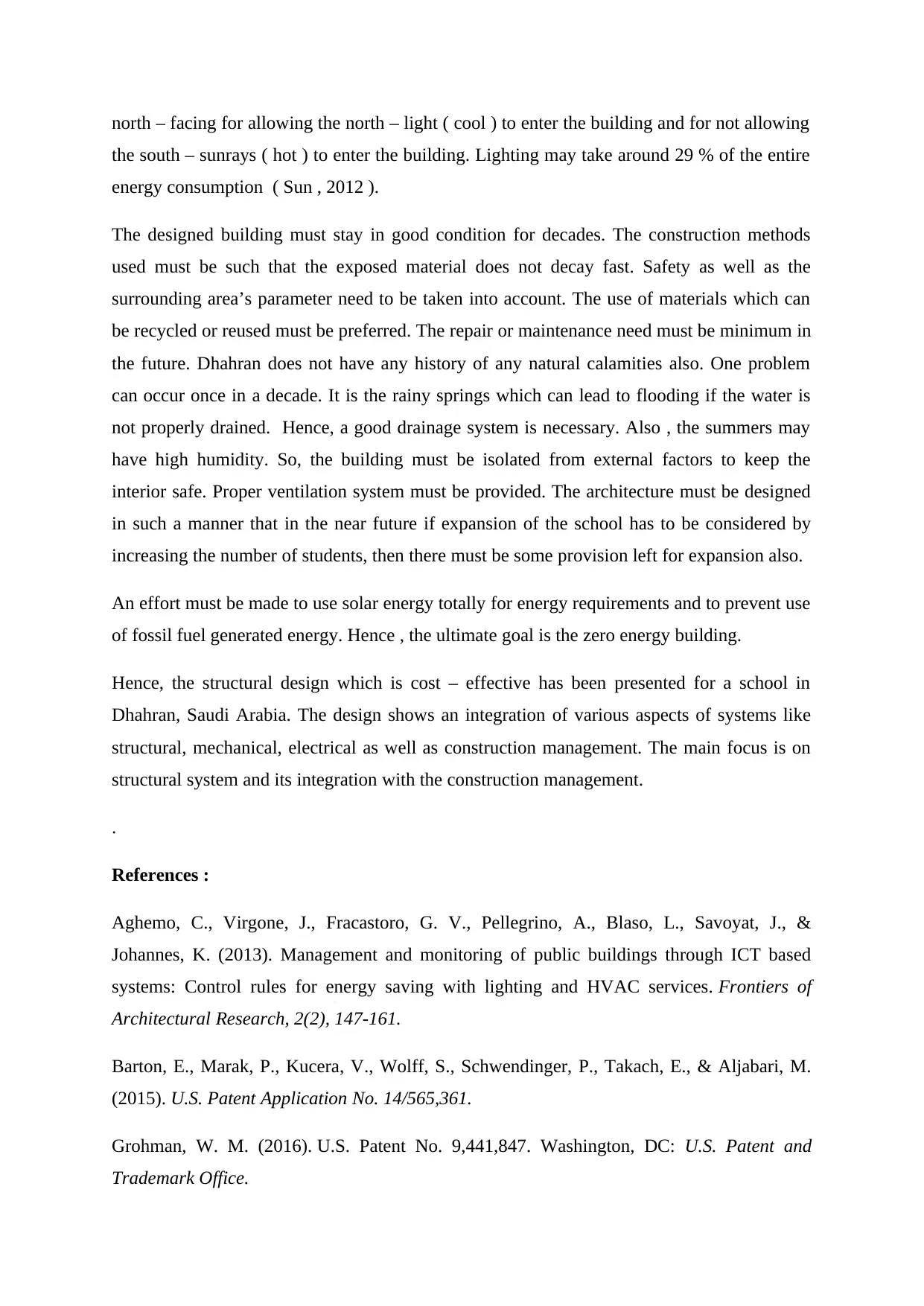Structural, Mechanical, Electrical Design: Dhahran School Project
VerifiedAdded on 2022/09/11
|3
|1057
|19
Project
AI Summary
This assignment presents a cost-effective structural design for a school in Dhahran, Saudi Arabia, integrating structural, mechanical, electrical, and construction management aspects. The design utilizes one-way slabs with beams and columns, incorporating ductless mini-split HVAC systems and energy-efficient lighting. The project emphasizes reducing energy consumption, particularly for cooling and lighting, by implementing strategies like shaded central spaces, north-facing windows, and potentially a roof garden. The design aims for a net-zero energy building using solar panels and a VRF HVAC system for optimal energy efficiency. The structural design considers local climate factors, including potential flooding and humidity, and prioritizes durable, recyclable materials and provisions for future expansion. The ultimate goal is to create a zero-energy building with minimal maintenance requirements.

Civil Engg
Mechanical and electrical system
Student Name -
Student ID -
Here, a structural design which is cost – effective , is presented for a school in Dhahran,
Saudi Arabia. The design is an integrated one which covers various aspects of systems like –
structural, mechanical, electrical as well as construction management. The major focus is on
structural system as well as integrating it with construction management. The cost estimation
is done in detail for specified cases of the complete school’s system.
The aim here is summoning the best building as far as the finances are concerned using a
school’s conventional layout ( in Dhahran ). For the structural system, the mechanical as well
as electrical systems are required like hvac system and lighting system. The one – way slabs
are used with beams and columns ( cast – in – place ) for all buildings.
The ductless mini split systems can be used for HVAC. The lighting power density is 5 W /
sq m or 0.46 W / sq ft ( Aghemo , 2013 ). A major portion of energy is used for cooling and
then for lighting. The energy load of the HVAC systems must be reduced so that the
electricity bill and hence the total cost is reduced ( Barton , 2015 ). An optimised value of
energy efficiency is needed. All the major mass must be concentrated around a space in
centre which is shaded. The windows must be designed in such a manner that any heat gain
due to direct sunlight is avoided ( Grohman , 2016 ). The geometrical shape of the building
must be simple to reduce the construction cost. On the top, a roof garden can be created. A
goal of Net – Zero building needs to be fulfilled by making use of solar panels. The HVAC
system chosen must have low operation cost, cooling efficiency must be good and the
capacity for cooling must be good enough to keep everyone inside the building in a
comfortable zone ( Perez – Lombard , 2011 ). VRF system is a good choice which has an
energy efficiency ratio ( EER ) of 14 EER. Cost wise also it is a good system.
For lighting the building, the day light must be harvested to minimize the use of electricity
and hence reduce the costs associated. A net – zero design in preferred. The windows must be
Mechanical and electrical system
Student Name -
Student ID -
Here, a structural design which is cost – effective , is presented for a school in Dhahran,
Saudi Arabia. The design is an integrated one which covers various aspects of systems like –
structural, mechanical, electrical as well as construction management. The major focus is on
structural system as well as integrating it with construction management. The cost estimation
is done in detail for specified cases of the complete school’s system.
The aim here is summoning the best building as far as the finances are concerned using a
school’s conventional layout ( in Dhahran ). For the structural system, the mechanical as well
as electrical systems are required like hvac system and lighting system. The one – way slabs
are used with beams and columns ( cast – in – place ) for all buildings.
The ductless mini split systems can be used for HVAC. The lighting power density is 5 W /
sq m or 0.46 W / sq ft ( Aghemo , 2013 ). A major portion of energy is used for cooling and
then for lighting. The energy load of the HVAC systems must be reduced so that the
electricity bill and hence the total cost is reduced ( Barton , 2015 ). An optimised value of
energy efficiency is needed. All the major mass must be concentrated around a space in
centre which is shaded. The windows must be designed in such a manner that any heat gain
due to direct sunlight is avoided ( Grohman , 2016 ). The geometrical shape of the building
must be simple to reduce the construction cost. On the top, a roof garden can be created. A
goal of Net – Zero building needs to be fulfilled by making use of solar panels. The HVAC
system chosen must have low operation cost, cooling efficiency must be good and the
capacity for cooling must be good enough to keep everyone inside the building in a
comfortable zone ( Perez – Lombard , 2011 ). VRF system is a good choice which has an
energy efficiency ratio ( EER ) of 14 EER. Cost wise also it is a good system.
For lighting the building, the day light must be harvested to minimize the use of electricity
and hence reduce the costs associated. A net – zero design in preferred. The windows must be
Paraphrase This Document
Need a fresh take? Get an instant paraphrase of this document with our AI Paraphraser

north – facing for allowing the north – light ( cool ) to enter the building and for not allowing
the south – sunrays ( hot ) to enter the building. Lighting may take around 29 % of the entire
energy consumption ( Sun , 2012 ).
The designed building must stay in good condition for decades. The construction methods
used must be such that the exposed material does not decay fast. Safety as well as the
surrounding area’s parameter need to be taken into account. The use of materials which can
be recycled or reused must be preferred. The repair or maintenance need must be minimum in
the future. Dhahran does not have any history of any natural calamities also. One problem
can occur once in a decade. It is the rainy springs which can lead to flooding if the water is
not properly drained. Hence, a good drainage system is necessary. Also , the summers may
have high humidity. So, the building must be isolated from external factors to keep the
interior safe. Proper ventilation system must be provided. The architecture must be designed
in such a manner that in the near future if expansion of the school has to be considered by
increasing the number of students, then there must be some provision left for expansion also.
An effort must be made to use solar energy totally for energy requirements and to prevent use
of fossil fuel generated energy. Hence , the ultimate goal is the zero energy building.
Hence, the structural design which is cost – effective has been presented for a school in
Dhahran, Saudi Arabia. The design shows an integration of various aspects of systems like
structural, mechanical, electrical as well as construction management. The main focus is on
structural system and its integration with the construction management.
.
References :
Aghemo, C., Virgone, J., Fracastoro, G. V., Pellegrino, A., Blaso, L., Savoyat, J., &
Johannes, K. (2013). Management and monitoring of public buildings through ICT based
systems: Control rules for energy saving with lighting and HVAC services. Frontiers of
Architectural Research, 2(2), 147-161.
Barton, E., Marak, P., Kucera, V., Wolff, S., Schwendinger, P., Takach, E., & Aljabari, M.
(2015). U.S. Patent Application No. 14/565,361.
Grohman, W. M. (2016). U.S. Patent No. 9,441,847. Washington, DC: U.S. Patent and
Trademark Office.
the south – sunrays ( hot ) to enter the building. Lighting may take around 29 % of the entire
energy consumption ( Sun , 2012 ).
The designed building must stay in good condition for decades. The construction methods
used must be such that the exposed material does not decay fast. Safety as well as the
surrounding area’s parameter need to be taken into account. The use of materials which can
be recycled or reused must be preferred. The repair or maintenance need must be minimum in
the future. Dhahran does not have any history of any natural calamities also. One problem
can occur once in a decade. It is the rainy springs which can lead to flooding if the water is
not properly drained. Hence, a good drainage system is necessary. Also , the summers may
have high humidity. So, the building must be isolated from external factors to keep the
interior safe. Proper ventilation system must be provided. The architecture must be designed
in such a manner that in the near future if expansion of the school has to be considered by
increasing the number of students, then there must be some provision left for expansion also.
An effort must be made to use solar energy totally for energy requirements and to prevent use
of fossil fuel generated energy. Hence , the ultimate goal is the zero energy building.
Hence, the structural design which is cost – effective has been presented for a school in
Dhahran, Saudi Arabia. The design shows an integration of various aspects of systems like
structural, mechanical, electrical as well as construction management. The main focus is on
structural system and its integration with the construction management.
.
References :
Aghemo, C., Virgone, J., Fracastoro, G. V., Pellegrino, A., Blaso, L., Savoyat, J., &
Johannes, K. (2013). Management and monitoring of public buildings through ICT based
systems: Control rules for energy saving with lighting and HVAC services. Frontiers of
Architectural Research, 2(2), 147-161.
Barton, E., Marak, P., Kucera, V., Wolff, S., Schwendinger, P., Takach, E., & Aljabari, M.
(2015). U.S. Patent Application No. 14/565,361.
Grohman, W. M. (2016). U.S. Patent No. 9,441,847. Washington, DC: U.S. Patent and
Trademark Office.

Perez-Lombard, L., Ortiz, J., & Maestre, I. R. (2011). The map of energy flow in HVAC
systems. Applied energy, 88(12), 5020-5031.
Pérez-Lombard, L., Ortiz, J., Coronel, J. F., & Maestre, I. R. (2011). A review of HVAC
systems requirements in building energy regulations. Energy and buildings, 43(2-3), 255-268.
Sun, B., Luh, P. B., Jia, Q. S., Jiang, Z., Wang, F., & Song, C. (2012). Building energy
management: Integrated control of active and passive heating, cooling, lighting, shading, and
ventilation systems. IEEE Transactions on automation science and engineering, 10(3), 588-
602.
systems. Applied energy, 88(12), 5020-5031.
Pérez-Lombard, L., Ortiz, J., Coronel, J. F., & Maestre, I. R. (2011). A review of HVAC
systems requirements in building energy regulations. Energy and buildings, 43(2-3), 255-268.
Sun, B., Luh, P. B., Jia, Q. S., Jiang, Z., Wang, F., & Song, C. (2012). Building energy
management: Integrated control of active and passive heating, cooling, lighting, shading, and
ventilation systems. IEEE Transactions on automation science and engineering, 10(3), 588-
602.
⊘ This is a preview!⊘
Do you want full access?
Subscribe today to unlock all pages.

Trusted by 1+ million students worldwide
1 out of 3
Related Documents
Your All-in-One AI-Powered Toolkit for Academic Success.
+13062052269
info@desklib.com
Available 24*7 on WhatsApp / Email
![[object Object]](/_next/static/media/star-bottom.7253800d.svg)
Unlock your academic potential
Copyright © 2020–2025 A2Z Services. All Rights Reserved. Developed and managed by ZUCOL.





